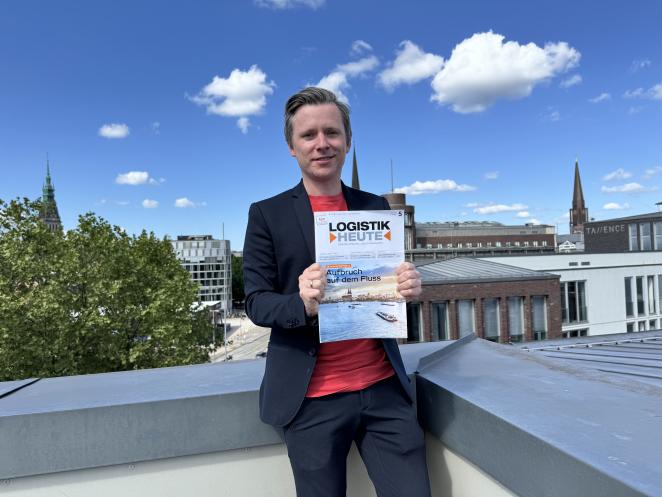In an interview with the German logistics trade magazine LOGISTIK HEUTE, the InnoWaTr project partner Thomas Brauner, Coordinator European Projects and Partnerships at the Logistics Initiative Hamburg recently had the chance to present & discuss the InnoWaTr project for their recently published May 2025 issue.

Delivering goods via Elbe and Bille: a new urban route
In a bold move to revitalize inland waterway logistics, the InnoWaTr (Innovative Waterway Transportation) project is piloting new applications for sustainable and resilient inland shipping. At the heart of this initiative is the Hamburg-based Freight Flow Coalition, coordinated by LIHH, which is testing real-world use cases for shifting freight transport to waterways.
The coalition, which includes TOP Mehrwert-Logistik and the Kühne Logistics University, is developing a supply route for a beverage wholesaler using the canal system of the Bille river & the Elbe river to deliver goods into the city’s HafenCity district. The project aims to explore how inland vessels can support last-mile logistics in urban areas, especially where road congestion or regulatory constraints limit conventional delivery methods.
“Many potential shippers are unaware of the possibilities of urban waterway logistics,” said Brauner. “This project is about overcoming operational hurdles and demonstrating that inland shipping can be a viable, sustainable alternative, not only in classic use cases but also in an urban context like city freight distribution.”
The pilot, set to test deliveries via waterways in the second half of 2025, faces challenges such as tidal fluctuations and lock schedules in Hamburg’s port & canal infrastructure. These real-world constraints are being studied in parallel through impact simulations.
Addressing the captain shortage: remote control innovation faces regulatory hurdles
Meanwhile, Seafar, a Belgian technology company, also part of the InnoWaTr project, is helping address another pressing issue in inland shipping: the shortage of skilled ship captains. As described in the LOGISTIK HEUTE article, Seafar has launched a Remote Operations Center in Duisburg in partnership with HGK Shipping and Reederei Deymann, enabling partial remote control of inland vessels. This innovation not only enhances operational flexibility but also makes the profession more attractive to younger generations by offering land-based, shift-based roles.
However, regulatory challenges in Germany are slowing progress. While remote-controlled inland vessels are already operating in Belgium’s canal system, similar implementations on the Rhine in Germany remain on hold due to the lack of necessary permits for live testing. The technical foundation—such as stable mobile network coverage and route mapping—is already in place, but the absence of dedicated administrative structures and slower approval processes have delayed deployment. In contrast, Belgium has established specialized offices to support smart shipping initiatives, enabling faster and more collaborative implementation.
Broader Context
The article also highlights broader challenges and opportunities in Germany’s inland shipping sector, including aging infrastructure, declining coal transport volumes, and the need for fleet modernization. Companies like BASF are investing in low-water-capable vessels, while Bayernhafen champions trimodal logistics and energy transition hubs. Despite its current marginal role in freight transport, inland shipping is gaining attention as a sustainable and scalable solution for the future.
Source: Thomas Brauner, Logistics Initiative Hamburg, based on the interview for LOGISTIK HEUTE, issue May 2025
